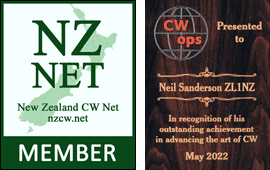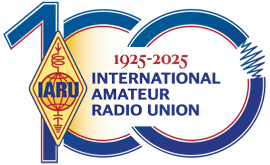This is a free fortnightly newsletter about the New Zealand Net.
If you would like to be notified by email when a new edition is published, please subscribe here.
Browse our Newsletter Archive and List of Net Tips.
Featured key
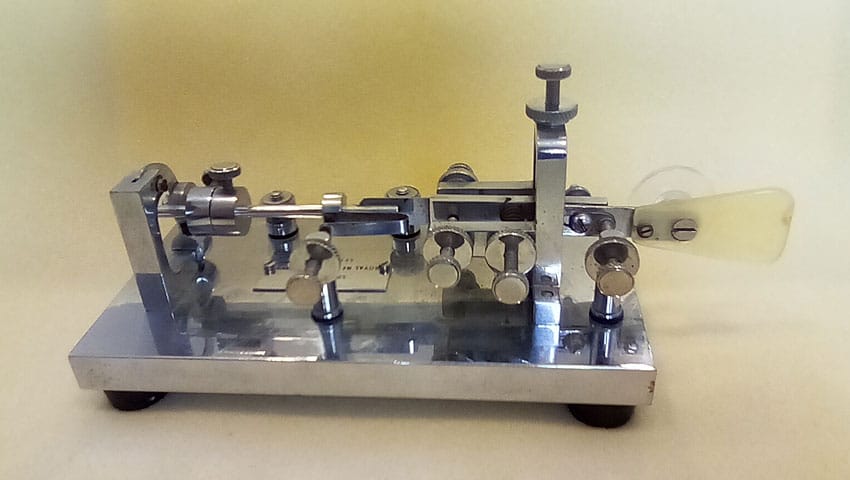
You might assume this photo shows one of Eric Sorensen’s lovely NZ-made Supreme bugs. You’d be right, but this is no ordinary Supreme bug. Notice the special identification plate on top of the base, which reads:
SPEED KEY
ROYAL NEW ZEALAND NAVY
Serial No. (not legible)
And if you were lucky enough to get your hand on this bug, you might notice that it feels different. That’s because the main pieces are plated brass, rather than the customary steel. The only ferrous metal parts are the dot and dash return springs, the pendulum and a couple of small screw/nut combinations. As a result, this bug is (almost) non-magnetic.
It also has four feet, instead of three as found on the popular amateur radio version sold by Tri-City House in Christchurch.
A very special bug indeed, from the collection of telegraphist Maurie Challinor ZL1FK of Auckland. Maurie said he did not know why the Navy used a non-magnetic bug. Could it have been for use aboard a minesweeper?
Thanks to Herman VK2IXV for compiling this information.
* If you have an interesting key for this feature, please send a nice clear photo and a few words describing it.
Quick notes
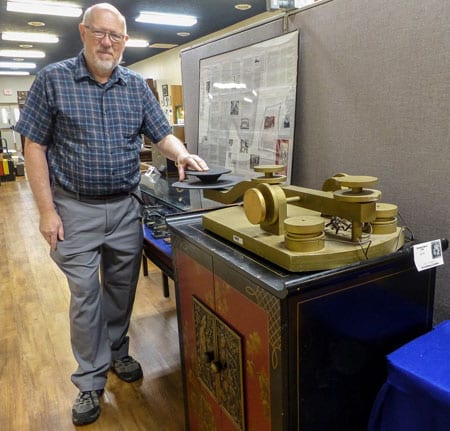 Greg ZL4GW is our new Net Control Station on Fridays. Greg is a highly experienced CW operator and we are pleased he has agreed to help us on the net. Bede ZL4KX is taking a break from NCS duty but will still do the occasional fill-in when possible.
Greg ZL4GW is our new Net Control Station on Fridays. Greg is a highly experienced CW operator and we are pleased he has agreed to help us on the net. Bede ZL4KX is taking a break from NCS duty but will still do the occasional fill-in when possible.
VKCW Net returns from summer holidays next Wednesday 5 Feb, and continues every Wednesday, at 0603Z on 14.049 MHz.
A much-loved poem, by telegraphist ‘Spru’ Spruhan, is featured in this edition of NZ Net News – but that turned out to be quite the challenge. I had four copies of it from various publications – but they were all different! I really wanted to reproduce the poem as ‘Spru’ had written it, so I was delighted when Kees VK1KVS was able to direct me to what appears to be the original publication from around 1950. The only change I have made to Spru’s text is to capitalise the parts that were telegraphed. A link to the original is included, too. Thank-you Kees.
Our next Straight Key Monday on NZ Net Net is 3 Feb. All ops are encouraged to use a straight key for that session. SKM is the first Monday of each month.
Pictured: Tom Cleveland VE3RSA on a straight key at the Antique Wireless Association museum in Bloomfield, New York. Photo: VE3GFN
Photo flashback
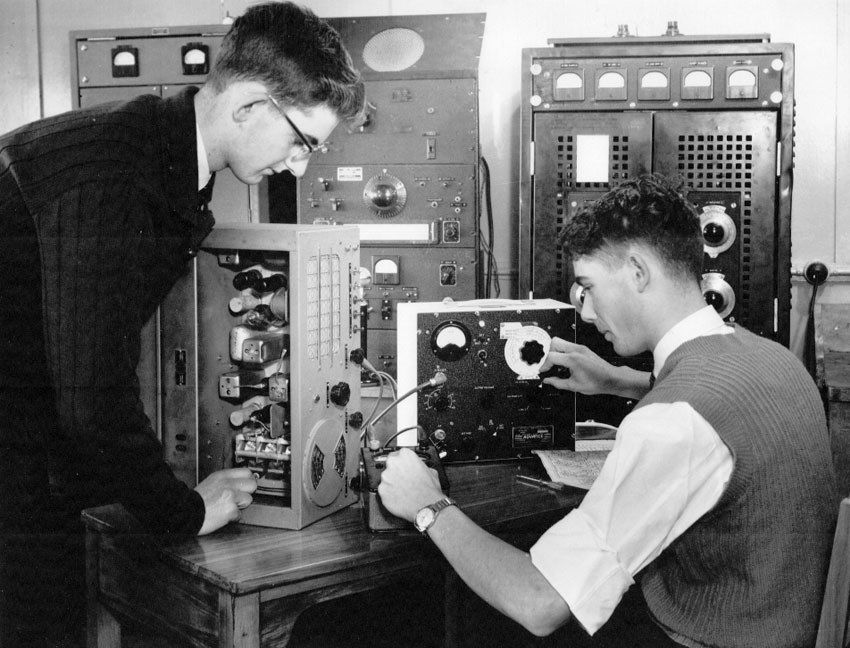
Courtesy Chris Underwood, maritimeradio.org
Here’s a scene at the NZ Post Office’s Trentham radio training school, which operated from 1949 until the early 1960s when training shifted to Rugby Street, Wellington. In the photo, trainees DC Moore (left) and AE Fletcher align a communications receiver using a signal generator and a multimeter. In the background is a 100 watt transmitter with its associated equipment, also used for training purposes.
Tiny transceiver a satisfying project
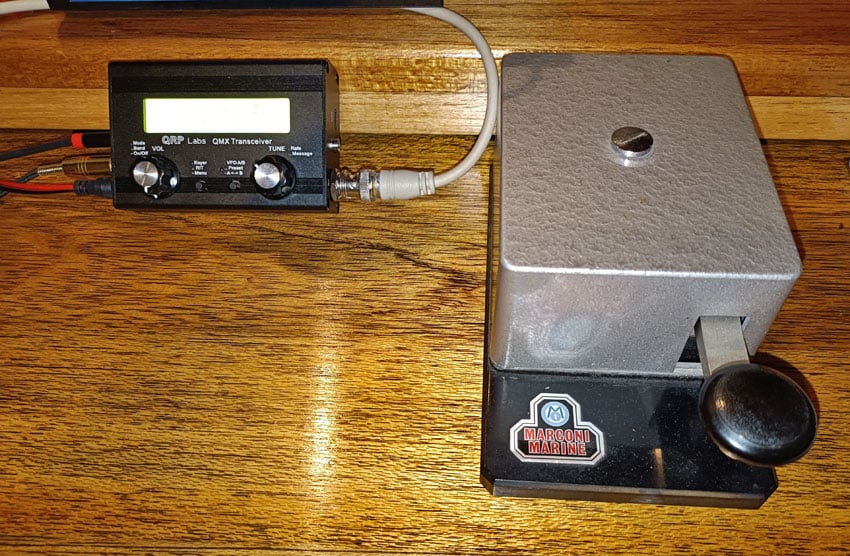
By David ZL2WT
A few of my friends are enjoying building Lego Technic models – they tell me that it keeps their brain cells alive! This gave me an idea to try and build a complex electronics kit.
The one I chose was the QRP Labs QMX transceiver. As you can see from the photo above, it is tiny – and dwarfed by the Marconi 365EZ key.
The QMX is a software defined radio, containing a 32-bit processor, loads of memory, ten miniature inductors that you have to wind with ultra thin wire, two switch-mode power supplies and a load of other components.
The kit costs about NZ$200. It is designed and marketed by an English engineer who is based in Turkey.
As I did not own a decent soldering iron, I had to invest in one before I could start. The whole build was conducted using a large magnifying glass.
On power-on, there was no smoke, but I did detect a couple of bugs. Fortunately the designer has coded a host of diagnostic routines into the QMX and all that was needed was to plug in a USB cable and run routines from a laptop in terminal mode. I actually enjoyed the challenge of bug-chasing, and found the problem was that the insulation had not been sufficiently cleaned on a couple of hair-thick enamelled copper wires.
I then connected a dipole aerial, which is slung over my wife’s vegetable garden, put the QMX into a digital communication mode on 14,074 kHz and immediately was in contact with someone in the Azores. Contacts with many European countries, USA, Pacific Islands and Australia soon followed. All interesting, but slightly boring. My signals were about 15dB lower than most, but at least I was getting through. I then connected a key to the QMX and gave a QNI onto the NZ Net. I received a strength report of 8 – which is OK for 4 watts.
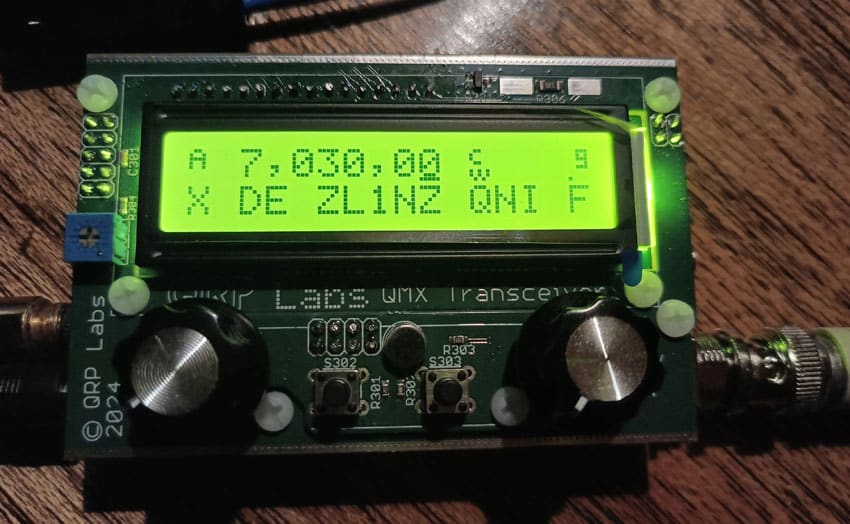
The building of the tiny transceiver was most worthwhile and I certainly got my money’s worth of enjoyment from the build.
Keeping up with Charlie Teede
Introduction by the late Barry Kirkwood ZL1DD (Adapted from Break-In, Aug 1987)
In Australia there once lived a remarkable character named Frank “Spru” Spruhan. He learned telegraphy before the turn of the 20th Century, and worked in Signals in World War 1, plus a spell as “Sparks at sea. Between the wars, he was a telegraphist at the Sydney GPO. He was a notable raconteur and wit.
When Spru approached retiring age in 1948, a committee of telegraphists collected many of his poems and stories, and published a book of them in his honour.
For over a century vast amounts of information were sent by hand telegraphy. Specialist operators sent Stock Exchange information, running transcripts of Parliamentary debates, and so on, as well as the standard telegrams. In the poem below, the operator was a specialist who ran commentaries on horse races over the wire.
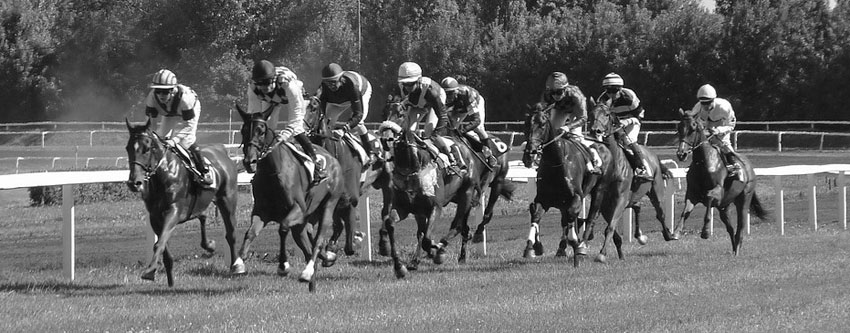
Coming round the bend
By Frank ‘Spru’ Spruhan
I well remember Charlie Teede,
Who used to work the races;
No need, indeed, to ask for speed,
He’d pace it with the pacers.
Lord help the man who “broke” him once
Or questioned his “creations”;
On him a flood of scorn was turned,
The atmosphere with brimstone burned,
And Pitman, green with envy, squirmed
At his abbreviations.“TE FIELD GOT WL AWA TO TI
& AS TY SETTLD DWN
TE SHICER 1ST T BK TE LI
WS FLWD BI JO BROWN.
IN CLOSE PROXIM WS TIRED TIM,
TN CME ARBTRATN,
BHND TE BUNCH WS CNTR LUNCH,
GD LUCK AND HI TAXATN.
TY WHIZZED ALNG (and so did Charles)
WTHOUT TE LEAST CESSATN.“C R T B TE TOPWT JUMPED
& GOT ON TRMS WI SHICR,
WO TN & TRE HS BUNDL DUMPD
WH LABLD HIM A TWICER.”
I scrambled after Charlie
like a trailer round a bend,
Then gave OK – but queried:
“C R T B U SEND.
NOW WHAT IS THAT IN AID OF?
ENLARGE A BIT MY FRIEND.”The sounder nearly hit the roof
as Charlie scorched the line:
“U ORT T BE ON TE RABTPROOF
OR UP AT DOODLEKINE.
CHASIN PODDIES RND TE YD
SHD B UR CHF PASTIME.
T TNK U CNDT WRK TT OUT
IT NRLY MKES ME SIK.
ANI OLE GIN OR ROUSABT
CD WRITE IT WI A STIK.“FANCI A MAN WO CALLS HMSLF
A TGST ASKG TT!
A RECORD O S VACUUM
IS LOCATED NEATH UR HAT.
D’ U WANT IT IN OILS BI LAMBERT?
OR CARVD ON A MARBL STONE?
OLE ‘WINJA’ MORTILL CD TKE IT
& UD NVR HR A MOAN;
NOT SPELT OUT LI IVE DUN FR U
BT CUT DWN T TE BONE.“WL I MST SA ITS TE BST DSPLA
OF IGNRNCE IVE HRD,
O ALL TE SQRTRS IN W A
UR CRTNLI TE BIRD
& ANI HRSH REMKS IVE MIST
TY ALL CN B INFERD
C R T B – ITS KNWN BI ROTE,
WT WD U HA ME SND?
ITS CMG RND TE BND – U GOAT
COMING ROUND THE BEND!”(From Frank Spruhan: “Coming Round the Bend” & Other Verse)
I think the abbreviation CNDT is a typo in the book. CDNT would make more sense to me, but I stand to be corrected.
Did you work out all the other abbreviations? We still use some of them, such as TT for “that”.
Other words are uniquely Australian. For more on those, see the glossary at the end of this newsletter.
Video: VKCW Net
Net tip: QNB
We continue our look at Q signals with one that you may hear used by the net control station: QNB.
It means: “Act as relay station between … and … “
Example
Net Control might know that VK3DRQ has a message for ZL4LDY, who is not copying well. So NCS could send:
ZL2GD QNB VK3DRQ ZL4LDY U5
This tells all 3 stations to move up 5kHz. ZL2GD would then call the other stations and, when everyone is on frequency, ZL2GD would ask VK3DRQ to send his message.
After ZL2GD has QSL’ed the message, he would ask ZL4LDY if he also copied it (QSL?). If ZL4LDY requests fills, or a full repeat, ZL2GD would then provide that.
After ZL4LDY has QSL’ed, ZL2GD would check whether either station has additional traffic (QRU?).
When all traffic has been cleared, ZL2GD would send BTN (back to net) and all 3 stations would move back to the net frequency and check in at the first opportunity.
The A-Z of Q Signals
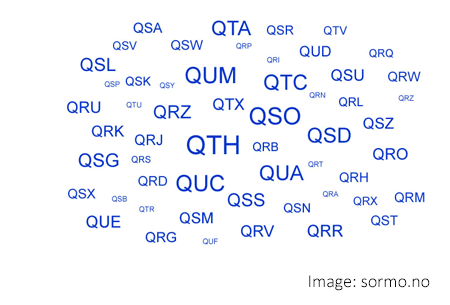
A well-run CW net is a lovely thing to experience. Communication between stations is quick and concise, and the net business is conducted with minimal time wasted.
As CW operators, we have many techniques to communicate quickly and efficiently. And if we know and use these techniques, we can often match or exceed the speed and accuracy of voice communication.
One of our most important tools is the set of Q Signals (or Q Codes), and in this series we look at the “essential” ones, in alphabetical order.
There will be some Q Signals that we rarely encounter, so that’s where a list kept near the radio can be helpful.
Advertising archive
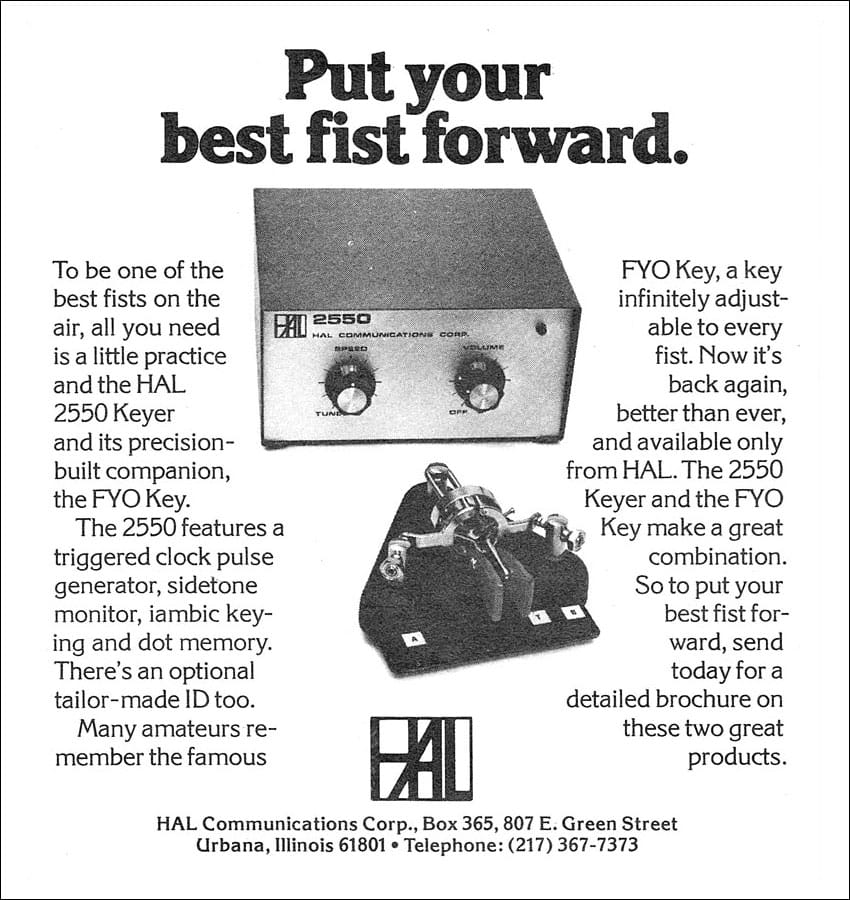
QST magazine, June 1976
Glossary for Coming Round the Bend
‘Spru’ – the abbreviation of names is common in Australia and Spru would have been a natural abbreviation of Spruhan. A ‘sprue’ is a superfluous piece attached to a casting and this word may have been known to some of Spru’s colleagues; telegraphists were very often highly intelligent men who were self-educated to a remarkable degree.
Broke – sending BK (break) to interrupt the sender. Usually to request a repeat or clarification. Some of the very fast telegraphists would delight in sending at full speed to a person with lesser skill and would become abusive if the person ‘broke’. Although this poem portrays this situation in a humorous way, it was often very nasty.
Pitman – refers to Pitman’s Shorthand.
SHICER – a goldminer’s term for a claim that produced little before it petered-out. Here it is used as a horse’s name, ‘The Shicer’ (which Charlie also abbreviates to Shicr after the first reference).
CNTR LUNCH – a Counter Lunch in an Australian pub. It was once common for a worker to go to the pub for lunch and have a few beers as well. Some telegraphists from the Central Telegraph Offices in the major cities were much addicted to this practice which may have affected their performance at work afterwards. Again, used here as a horse’s name.
TOPWT – Topweight is a racing term for the horse carrying the highest weight handicap in a race.
BUNDLE DUMPED – dumping your bundle means giving up. Probably originates from retreating soldiers who threw-away their gear.
TWICER – a ‘flash-in-the-pan’, applied to sportsmen, politicians and to persons who show some brief promise that doesn’t last. Here it’s a horse which does well a couple of times and never does well afterwards.
RABTPROOF – Rabbit-proof fences were erected and maintained between some Australian states to keep rabbits (a plague in Australia) from moving about. There are many bush stories about the rabbit-proof fences and the somewhat eccentric men (‘hatters’, from the Mad Hatter) who maintained them, thousands of miles from civilisation.
DOODLEKINE – a tiny settlement in West Australia. Used by Spru as a synonym for remoteness.
PODDIES – unweaned calves.
GIN – an Aboriginal woman. (Considered racist. – Ed.)
ROUSABT – a rouseabout is an unskilled bush labourer, not a ‘tradesman’ like a stockman or a shearer.
O S – oversize, as in hats, shirts, etc.
LAMBERT – George Lambert was a well known Australian artist.
WINJA – otherwise ‘whinger,’ a person who is always complaining. ‘Whinger’ Mortill was a telegraphist who was known for this habit; he is mentioned in other poems and writings.
SQRTRS – probably related to “squirt”, a callow youth.
WA – West Australia.
THE BIRD – Perhaps Spru meant Galah, an Australian bird; a fool is called a galah in Australia but Spru needed a rhyme with ‘inferred’.
(Adapted from the late Ron McMullen’s The Australian Telegraph Office) and from Morsum Magnificat 58
Suggestions?
If you have suggestions on how to make the NZ Net better, or things you’d like to see covered in these updates, please contact ZL1NZ. You might even like to write something for the newsletter.
Thanks for reading, and I hope to hear you soon on the NZ Net!
—
Neil Sanderson ZL1NZ, Net Manager
New Zealand Net (NZ NET)
7030 kHz at 9pm NZT Daily


